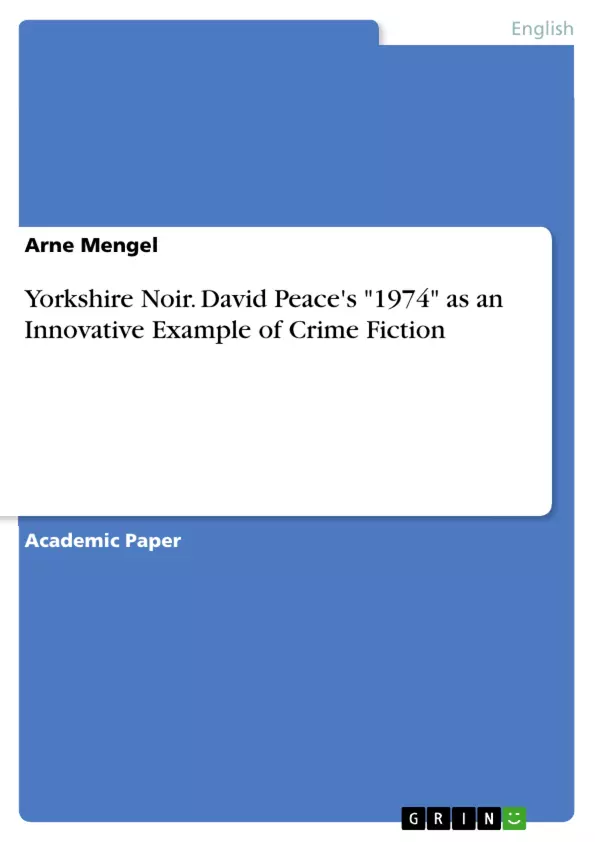This paper will look at crime fiction theory and investigate whether on the one hand the different concepts of classic literature can be applied to "1974" and on the other hand in which ways "1974" is innovative in establishing its own rules.
When analysing crime fiction, there are many aspects and characters to focus on. Due to the volume of the paper, not everyone of those will be considered. The paper is divided into literary concepts, central characters as well as central aspects of crime fiction and Peace's language, before talking about Yorkshire Noir fiction and coming to a conclusion. After a brief introduction to literary concepts of crime fiction, central characters like the detective (in more detail), followed by the police, and finally the offenders and the victims will be examined. Turning towards the central aspects, on the one hand fear and paranoia; crimes, investigation and solution; interrogation and confession will be discussed, as well as corruption and conspiracy, and series at last. After taking David Peace's language into consideration, classifying "1974" as Yorkshire Noir fiction constitutes the last section of this paper before the closing words.
Inhaltsverzeichnis (Table of Contents)
- Introduction
- Introduction to 1974
- Abstract
- Literary Concepts of Crime Fiction
- Typical Characters Found in Crime Fiction
- The Infected Detective
- The Police - the Good Guys?
- Hunted and Hunter: The Victim and the Offender
- Typical Aspects of Crime Fiction
- Fear and Paranoia
- Crime, Investigation and Solution
- Interrogation and Confession
- Corruption and Conspiracy
- Serial Crime Fiction: 1974 in the Context of the Red Riding Quartet
- Sex, Violence and Murder: The Language of David Peace
- Yorkshire Noir
- Conclusion
Zielsetzung und Themenschwerpunkte (Objectives and Key Themes)
This paper examines David Peace's 1974, exploring its deviation from conventional crime fiction narratives. It investigates how the novel challenges traditional genre conventions, particularly in terms of character portrayal, plot structure, and thematic focus.
- The portrayal of a flawed and unreliable detective
- The exploration of police corruption and its impact on the investigation
- The blurring of lines between victims, offenders, and investigators
- The use of violence, sexuality, and graphic language as narrative tools
- The depiction of Yorkshire as a dark and brooding setting
Zusammenfassung der Kapitel (Chapter Summaries)
The introduction presents David Peace's 1974 as a unique and unconventional crime fiction novel, highlighting its distinct characteristics within the Red Riding Quartet. Chapter 2 explores literary concepts of crime fiction, examining the traditional structure and character types often found within the genre.
Chapter 3 delves into typical characters found in crime fiction, focusing specifically on the role of the detective in 1974. The chapter examines the complexities of Edward Dunford's character, showcasing his flaws and how he differs from the traditional detective figure.
Chapter 4 explores typical aspects of crime fiction, including fear and paranoia, crime investigation, interrogation and confession, and corruption. The chapter examines how 1974 utilizes these aspects while simultaneously deviating from conventional formulas.
Chapter 5 focuses on the language employed by David Peace in 1974, highlighting the use of violence, sexuality, and graphic imagery to create a unique and impactful narrative.
Schlüsselwörter (Keywords)
The primary keywords and focus topics include crime fiction, Yorkshire Noir, David Peace, 1974, the Red Riding Quartet, unreliable detective, police corruption, violence, sexuality, language, and the portrayal of a dark and brooding Yorkshire setting.
- Quote paper
- Arne Mengel (Author), 2021, Yorkshire Noir. David Peace's "1974" as an Innovative Example of Crime Fiction, Munich, GRIN Verlag, https://www.grin.com/document/1356266



